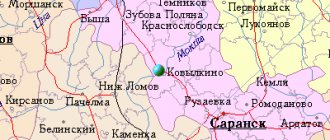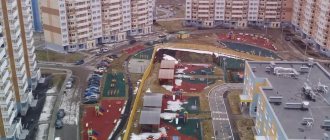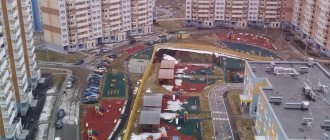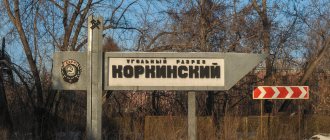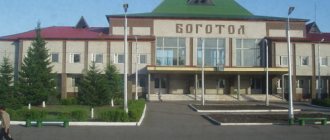Domodedovo
, a city of regional subordination in Russia, the administrative center of the Domodedovo district of the Moscow region, the cathedral city of the Domodedovo Vicariate of the Archdiocese of Russian Churches in Western Europe and the center of the Domodedovo deanery of the Podolsk diocese. Located on the Moskvoretsko-Oka Plain, in the center of the East European Plain, 37 km south of Moscow. Railway station on the Moscow-Pavelets line. Population - 124.3 thousand (2017)
- Official site:
- On the map: Yandex.Map, Google map
The name of the city was given by the village of Domodedovo, the first mention of which was in 1401 in the spiritual charter of Vladimir Andreevich the Brave, Prince of Serpukhov and Borovsky. The territory of the modern city is located on an ancient road - the Kashira tract, which for many centuries connected Moscow with Kashira and other cities in the southern direction.
In the 17th century, the borders of Domodedovo included two ancient villages - Nazaryevo and Sknilovo, the exact date of whose disappearance is unknown. From the village of Sknilovo there is only one ravine left, which is now called Sknilovsky, located between Tekstilshchikov and Michurina streets.
In 1775, during the reforms of Catherine II, the city of Nikitsk, a district of the Moscow province, was formed on the site of the village of Kolycheva on the Pakhra River. Its borders included the villages of Domodedovo, Nikitskoye, Bityagovo, Zaborye. In 1796, by decree of the son of Empress Paul the First, Nikitsky district was abolished, and the village was returned to its previous status - the village of Kolychevo.
In 1812, the French army retreated through the territory of the future city in the direction of Podolsk, leaving Moscow.
In 1825, the owner of the Konstantinovo estate, state councilor I.F. Pokhvisnev, founded a paper spinning factory. Not far from the factory, a small workers' village was built with a medical assistant's reception and a school for the children of workers.
Until the mid-19th century, the city's territory was a wasteland overgrown with small bushes and deciduous trees. During the peasant reform of 1861, on parts of the lands of the Domodedovo volost of the Podolsk district, the Domodedovo Palace Forest Dacha was formed, the territory of which was divided into quarters, where planned deforestation and brushwood collection were carried out. Land plots cleared of forest were rented out for the construction of dachas.
In 1897, construction began on a railway line of the Ryazan-Ural Railway from Pavelets to Moscow, which passed through the Domodedovo volost. The station, 34 km from Moscow, was named after the village of Domodedovo, the administrative center of the volost, located five kilometers away. On January 19, 1900, the grand opening of the Domodedovo station took place and regular passenger and freight traffic began in the Moscow-Pavelets direction.
At the beginning of the century, a station village was founded not far from the station, factory villages began to appear, and the dacha village and the village of the Konstantinovskaya factory expanded. In 1919, the first educational school was opened in the station village. During the summer, summer residents from Moscow settled in the village of Domodedovo.
In 1924, by a resolution of the Podolsk district executive committee, the station village of Domodedovo was classified as an “urban-type dacha village.” And in 1928, a dacha council was elected.
In connection with the reconstruction of the city of Moscow, about 200 Muscovite families moved to the Domodedovo village in 1937. In 1938, the workers' village of Domodedovo was formed, which developed along the Kashirskoye Highway, between the railway line and the Rozhaika River.
The development of the village was delayed by the Great Patriotic War. In the first post-war years, Domodedovo industrial enterprises quickly restored their production potential. Along with the industrial development of the workers' settlement, housing and domestic construction took place.
On March 12, 1947, the workers' settlement was transformed into a city of regional subordination.
On April 7, 1962, near the city of Domodedovo, construction began on the airport of the same name, which opened regular passenger air services in 1966.
In 1965, the working settlement of the Konstantinovskaya wool-spinning factory entered the city limits.
In 1969, the city of Domodedovo became a city of regional subordination and the center of the new Domodedovo district, separated from the Podolsk region.
On August 11, 2003, the administrative division of the city into Northern, Central, Southern and Western districts was approved.
On July 19, 2004, the working village of Vostryakovo became part of the city of Domodedovo, and the holiday village of Barybino became part of the holiday village of Belye Stolby, and on September 17 of the same year, the holiday village of Belye Stolby was annexed to the city of Domodedovo.
On December 15, 2004, the municipal formation “Domodedovo District of the Moscow Region” was granted the status of an urban district.
On March 14, 2007, the villages of Zaborye, Metkino, Rozhdestvenskoye, Umshary and the village of Shebantsevo were transferred to the city. On September 7 of the same year, the Domodedovo urban district was divided into seven microdistricts, and later into nine.
Religion
On May 6, 1991, the Domodedovo deanery of the Moscow diocese was formed, and the city became its center.
The Church of St. Seraphim of Sarov, the Cathedral of All Saints Who Shined in the Russian Land and the Church of the Nativity of Christ were erected in the city. Since 2000, an Orthodox gymnasium began operating at the cathedral.
On May 16, 2007, the Domodedovo Vicariate of the Moscow Diocese was established, named after the city of Domodedovo.
Temples
- Boris and Gleb
- "The Queen of All", icons of the Mother of God
- All Saints who shone forth in the Russian land, Cathedral
- St. George the Victorious
- Demetrius of Thessalonica
- John of Kronstadt
- Cosmas and Damian
- "Burning Bush", icons of the Mother of God
- Nicholas the Wonderworker
- New Martyrs and Confessors of Domodedovo
- Peter and Fevronia
- Nativity of John the Baptist
- Nativity of Christ
- Nativity of Christ in the village of Barybino
- Seraphim of Sarov, baptismal
- Tikhvin Icon of the Mother of God
- Feodorovskaya Icon of the Mother of God
Historical reference
Historians say that 200 - 300 million years ago, the sea splashed over the Domodedovo land. Even traces of it have been preserved - deposits of limestone, on the blocks of which the imprinted remains of marine animals can be seen. The glacial era left behind deep river valleys and deposits of sand and red clay in the area. Mammoths once roamed here.
Local historians date the first mention of Domodedovo in ancient writings to 1401. For many centuries, the ancient Kashira Highway ran here, connecting Moscow with the south. The first owner of the village of Domodedovo was Elena Olgerdovna, the wife of the Serpukhov-Borovsk prince Vladimir Andreevich. And at the beginning of the 18th century, Prince A. Menshikov, an associate of Peter I, was granted the Domodedovo and Myachkovo volosts.
Since ancient times, there have been other settlements nearby. Therefore, it is quite possible to assume a more ancient history of Domodedovo villages. The Resurrection Church in the village of Bityagovo (1670), the late classicism estate in Konstantinovo on the site of the estate of the Romodanovsky princes, which belonged to the famous traveler N.M. Przhevalsky in the second half of the 19th century, and the Morozov estate of the outstanding Russian architect F.O. Shekhtel have been preserved. The Resurrection Church (1697) in the village of Kolychevo is protected by the state. In 1781, Catherine II awarded this village “the name, rights and advantages of the city” under the name Nikitsk. It was proclaimed the center of the district; 747 people lived here at that time; they were occupied “partly in arable farming, and more in breaking and preparing white stone,” from which the best buildings of Moscow, Vladimir and other cities of the Golden Ring were built. Since 1802, Nikitsk disappeared from the list of Russian cities, the name of the village of Kolychevo was restored, but the coat of arms of the ancient city became the basis of the current Domodedovo coat of arms.
The Domodedovo land remembers how in 1812 the columns of General D.S. Dokhturov and Field Marshal M.I. Kutuzov moved through the village of Yam. French troops leaving Moscow also passed along the Kashirskaya road.
At that time, quarries and flour mills stood out from industrial production. In 1825, the landowner Pokhvistnev built one of the first paper spinning factories in Russia - the oldest enterprise in the city. Then a brick and lime factory were built, and by 1908 two more factories were operating.
In connection with the reconstruction of Moscow, about 200 Muscovite families moved to Domodedovo in 1937. In 1938, a workers' settlement was formed, the number of its residents reached 8.7 thousand people.
In 1941, Domodedovo, where 14.5 thousand residents already lived, was transferred to the category of a workers' village.
The development of the village was delayed by the Great Patriotic War. In the first post-war years, Domodedovo industrial enterprises quickly restored their production potential.
Along with industrial development, housing and household construction took place.
On March 12, 1947, the workers' village was transformed into a city of regional subordination, and in 1969 a new district was formed, with its center in Domodedovo. On January 1, 2006, the area was transformed into the Domodedovo urban district.
City information
Domodedovo is a city in the Moscow region. Located in the west of the Russian Federation. The economy is represented by enterprises in the construction industry and the production of equipment for the oil and gas industry.
The Moscow-Kashira highway passes through the settlement, and the M-4 Don federal highway runs nearby. The railway line and the large airport of the same name are located nearby. Universities and their branches, professional and secondary specialized educational institutions operate in the settlement. Cultural institutions are functioning. A significant part of the population is employed in the capital of the Russian Federation.
Coat of arms
The Domodedovo coat of arms is presented in the form of a French shield. There is a red stripe at the top. Below it is a golden background, on top of which is an azure pillar (the symbol of the airport). Below are three lowered silver bars, with the top and left edges visible. They are stacked in the rafters. They symbolize modern industry focused on the production of building materials. In the upper left part is the coat of arms of the Moscow region (this is an optional element).
The artistic composition is based on a version of the now defunct city of Nikitsk. Adopted by the Decision of the Council of Deputies of the Domodedovo District of March 22, 2002 No. 37/5.
Chronicle of the development of the city of Domodedovo
The first settlements and the beginning of the development of the city
The first people to inhabit the territories of Domodedovo were the Slavic tribes - the Vyatichi. Based on archaeological excavations, it can be assumed that the first settlements appeared in the 8th
centuries.
The first mention of Domodedovo was recorded in 1401
in the spiritual charter of Prince Vladimir the Brave. There are many versions of the origin of the name of the city, but two versions are considered the most popular: according to one version, the city was named in honor of the home makers who lived in this territory; according to another version, the city was named after one of the owners of these lands.
After Vladimir the Brave, his wife became the owner of Domodedovo, but in 1433
year she decides to go to the monastery and transfer her possessions to her daughter-in-law Ulyana.
In the 17th century
, the Romanovs began to own Domodedovo, and they owned it until the death of the last person from the dynasty, Nikita Ivanovich. After his death, Alexey Mikhailovich became the owner. When Peter I came to power, he handed Domodedovo over to Count Menshikov, but very soon the lands were returned to the nobility.
The First World War and Domodedovo in the 20th century
During the First World War, the city of Domodedovo played an important role.
The path of the Russian army passed through the territory of the city, and Domodedovo was also important in the defense of the country's territories. In 1900
The construction of the railway that runs through Domodedovo begins.
This road was supposed to connect Ryazan and Moscow. After 3
years, two factories were built in Domodedovo and, in connection with this, new people moved to the city, the population increased to
177
people.
Later, in 1913
, Domodedovo received the title of an urban-type settlement, the population increased to
250
people, and about
200
summer residents came here.
The population continues to increase in 1937
year.
New houses are being built, the area is being improved, schools, hospitals, and shops are appearing. During this period the population increased to 7
thousand people. A year later, Domodedovo was transformed into a workers' settlement, and industrial buildings began to be built.
Status of the city and a new stage in the development of the city
In 1947
, Domodedovo received city status.
A few years later, the construction of large industrial enterprises began in the city. In 1969
, an airport was opened in Domodedovo, partly thanks to this the city became an industrial center. By that time, the city was already well developed: several schools, libraries, a theater building, a cinema, a house of pioneers and several hotels.
The airport has become an important element of the city. It carried not only people, but also various parcels, documents, and also carried out private transportation. There is an interesting fact that the first passenger was a woman with a baby, and airport workers took this as a good sign for their enterprise.
Initially, the airport transported people only to Siberia, Central Asia, the Urals, the Volga region and the Far East, but soon the airport was given international status.
IN 2000
The demolition of old buildings and the construction of modern multi-storey buildings in their place begins. In the same year, Orthodox gymnasiums began operating at the Church of Seraphim of Sarov and the Cathedral of All Saints.
July
19 2004
, by order of Domodedovo, the village of Vostryakov and the holiday village of Belye Stolby were annexed.
Domodedovo in our time
The city is growing and continues to develop. In 2014
, the population exceeded
100 thousand people. This small city has its own attractions: a local history museum, an ecological park, a museum of fairy tales and many monuments dedicated to military events.
The city of Domodedovo has its own legend
As part of a project designed to perpetuate the history of its native city, MegaFon will give the city of Domodedovo a new landmark - a sculpture of Grandfather Domodel. The name of the town of Domodedovo near Moscow comes from the legend of an old bird catcher. His nickname gave the name to the village of the same name, which is mentioned in written sources starting from the 15th century, and then to the modern city. In the album “History of the Principality of Serpukhov” it is said this way: “And the village on the wasteland near Serpokhov, across the river, was named in the name of the Elder Domodel. For they say that in those places the old man lived much more skillfully, he always caught birds in the forests, and he made beautiful cages from vines. And he did not trade them every day, but only on Saturdays and Sundays, and on other days he gave birds and cages to girls who were already in marriage. For this reason, this old man was revered for his skillful deeds and was nicknamed Do-Model.” In other words, the elder gave the newlyweds birds and skillfully woven cage houses as a symbol of a prosperous married life, or perhaps as a talisman so that good things would accumulate and not be transferred. Perhaps rumors about him spread during his lifetime, and the area where he lived began to be called “Domodelova”, which by the 15th century turned into “Domodedovo”. The Domodel sculpture is a gift to the city of Domodedovo as part of the “MegaFon Gives a Legend” project. One of the goals of this project is to attract the attention of residents to the history of the city and create an important city landmark associated with traditional family values. Today, many people want to learn more about their native places, to feel the connection between times and generations. Therefore, the appearance in the city of a sculpture that will remind residents of the main local legend is an important contribution to strengthening city traditions. The sculpture of Grandfather Domodel with a wicker basket over his shoulder, located in the city park next to the Alley of Lovers, will become the center of cultural leisure for citizens, an attraction for tourists, a venue for children's parties and, of course, wedding ceremonies. Starting a family is one of the main and brightest moments in the life of every person. And the wedding ceremony is that very step towards the future, which the newlyweds will then remember with warmth all their lives. The sculpture will not only remind them of history, but also, quite possibly, will bring good luck - after all, it was thanks to the wonderful art of Domodel that news of him not only reached our days, but also gave the name to the whole city.
Information note The author of the monument is Kirill Chizhov, a young talented sculptor, a student of the famous A.I. Rukavishnikov, a graduate of the sculpture department of the Surikov Moscow State Academy of Arts. Almost at the age of 20, he became a prize-winner of the All-Russian Competition of Young Artists at the State Tretyakov Gallery, and soon became a member of the Moscow Union of Artists. Art critics consider Kirill one of those few modern creators who are capable of bringing light, strength, and spontaneity. Having experienced the influence of many styles in his development - academicism and neo-academicism, surrealism, avant-garde and postmodernism, Kirill Chizhov created his own style - a lively, confident, eclectic and very energetic fusion, with a subtle taste and flair for even the smallest details.
Any use of materials is permitted only if there is an active link to the Domodedovo city website
